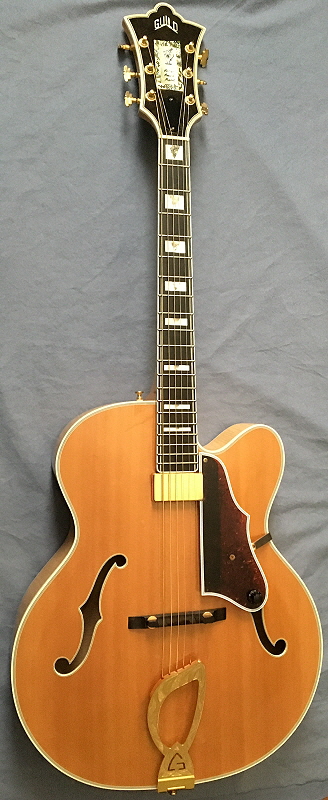

FACTOIDS AND TRIVIA
The Artist Award model started life as the Johnny Smith Award. After Johnny Smith dropped his endorsement, Guild changed the model name to Artist Award, but continued to use the "pitcher and star" motif on the headstock. In 1963, the body shape was changed from the 1950s Epiphone inspired narrow-waist to a Gibsonesque wide-waist body that was used on all Guild 17-inch archtops until their discontinuation. The body depth changed a few times as well, from 3 1/8 inches to 3 3/8 inches in the early 1970s to 3 inches in 2000. Because Guild guitars were handmade, dimensions can vary from factory specifications and the guitar below is good example (see body depth and nut width). The cosmetics continued to be refined with an upgrade from 5-ply binding on the headstock and body to 7-ply body binding and 9-ply headstock binding in 1971 and then again in 2000 to 13-ply for the headstock and 9-ply for the body. A mahogany backstripe was added by the end of 1975 and then deleted in 2000. Scale length changed as well, beginning with 24 3/4" for the Johnny Smith Award, then to 25 1/2" around 1969 and then to 25 5/8" in the mid-1980s. The Grover Imperial tuners were changed to Grover Super Rotomatics in 1989. Four types of floating pickups were fitted over the years: DeArmond 1000 (1961-66), DeArmond 1100 (1967-84), a thinline humbucker of unknown make (1985-99) and Benedetto (2000-02). The guitar shown here uses an offset bracing design where the bass-side brace is shifted toward the f-hole and the treble side brace is in the usual location running under the foot of the bridge. In addition, the treble side brace is thin and V-shaped while the bass side brace is wide and U-shaped. This is one way to gain balance between high and low response. If the Guild catalogs are to be believed, the body was constructed from German maple in the 1990s. The specifications on the Guild website from April 1998 shows the top being made from German spruce, but this contradicts the specifications in the printed catalogs from the same period. So, who knows what kind of spruce it really is? The Benedetto makeover of the Artist Award in 2000 resulted in a completely different guitar that only cosmetically resembled the previous version. The body depth was reduced and the top (now European spruce) was X-braced instead of parallel braced. The Benedetto Artist Award was dropped in mid 2002 to make way for the Johnny Smith Award. The final version of the Artist Award was a near clone of the short scale, parallel-braced 1962 Artist Award. This version was part of Guild's Patriach series and was only available in 2013-14.
The guitar shown here has an open acoustic voice, but does not possess the volume of a true acoustic-only archtop. Like most modern archtops, the design is really meant to be an amplified-archtop and so is a compromise that has adequate acoustic tone while providing some feedback resistance. The no-name pickup is muddy sounding compared to other popular humbuckers such as Kent Armstrong, DeArmond and Benedetto. The wide neck and slightly-longer-than-usual scale length is great for fingerstyle playing, but may be a bit challenging for some players until they become accustomed to it.
GUILD ARTIST AWARD (1996)


Body: Hollow; solid 2-piece Sitka spruce top, solid 2-piece flame German maple back and sides; 9-ply bound top and back
Finish: Natural, nitrocellulose lacquer
Neck: 5-piece flame maple, set-in; 9-ply bound headstock with abalone and mother-of-pearl logo and inlay
Fingerboard: Ebony, bound; mother of pearl block markers with abalone inserts
Number of Frets: 20
Pickguard: Tortoloid plastic, 5-ply bound
Bridge: Ebony on ebony base; Guild harp tailpiece, gold
Nut: Bone
Tuners: Grover Super Rotomatic, gold
Pickups: One, Guild floating humbucker , gold
Controls: Master volume
Scale Length: 25 5/8 inches
Neck Width at Nut: 1 3/4 inches
Body Width at Lower Bout: 17 3/16 inches
Body Depth: 3 1/2 inches
Weight: 6.7 lb